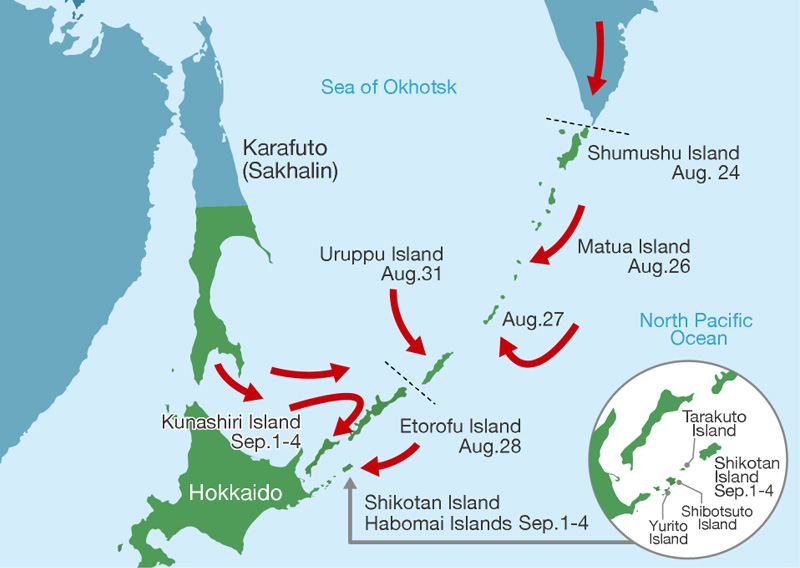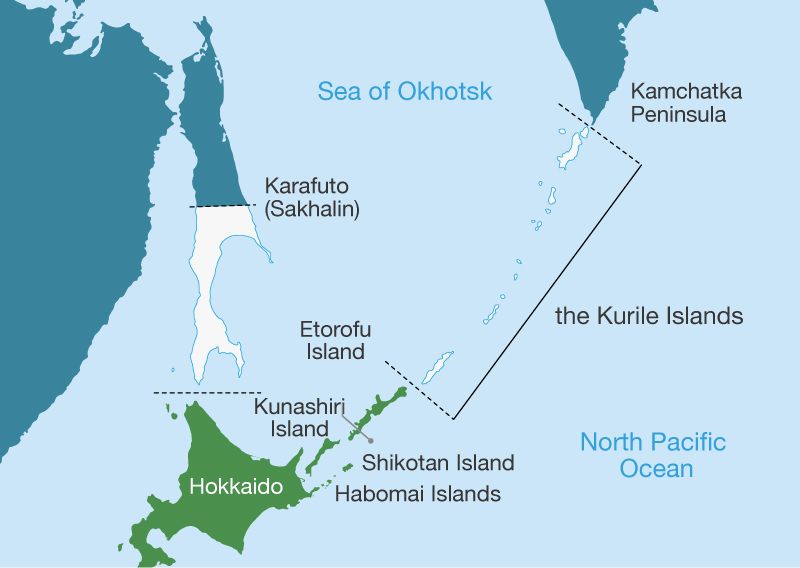Rise of the Territorial Dispute
April 1941
Neutrality Pact between Japan and the Soviet Union
Under this Pact, Japan and the Soviet Union undertook the obligation to mutually respect the territorial integrity and inviolability of the other. The Pact was to remain in force for a period of five years, and unless either Party notifies the denunciation of the Pact a year before the expiration of that period, it was to be considered to be automatically extended for the next period of five years. The Soviet Union made the notification of denunciation in April 1945, as a result of which the Pact remained in force until April 1946.
August 1941
Atlantic Charter
The Allies clarified the principle of seeking no territorial aggrandizement.
The leaders of the US and the UK signed the Atlantic Charter to state the common principles of the Allies, among which was to seek no territorial aggrandizement. The Soviet Union also joined the Atlantic Charter on September 24, 1941.
November 1943
Cairo Declaration
Confirmation by the Allies of the common principles, including the principle to seek no territorial aggrandizement.
In the Cairo Declaration, the Allies confirmed the principles of the Atlantic Charter, including the principle to seek no territorial aggrandizement and stated “Japan will also be expelled from all other territories which she has taken by violence and greed.” It is clear in the light of historical facts that the Four Northern Islands were never “taken” by violence and greed by Japan.
February 1945
Signing of the Yalta Agreement by the leaders of the US, the UK and the Soviet Union
The Agreement included the handing over of the Kurile Islands to the Soviet Union, along with the return of the southern part of Sakhalin to the Soviet Union.
The leaders of the US, the UK and the Soviet Union signed the Yalta Agreement, which included the handing over of the Kurile Islands to the Soviet Union, along with the return of the southern part of Sakhalin to the Soviet Union. But the Yalta Agreement was merely a statement by then leaders of the Allies as to principles of the postwar settlement, and was not a determination by the Allies concerned of the final settlement of territorial problems. Furthermore, Japan, not being a party to this agreement, is in no way bound by it.
1945
Potsdam Declaration
The Potsdam Declaration of July 1945 indicated that the terms of the Cairo Declaration shall be carried out, and that Japanese sovereignty shall be limited to the islands of Honshu, Hokkaido, Kyushu, Shikoku and such minor islands as the Allies determine. This declaration did not determine the final settlement of territorial problems. The Soviet Union joined the Potsdam Declaration on August 8, 1945. Japan accepted the Potsdam Declaration on August 14 of the same year.
1945 –
Opening of war against Japan by the Soviet Union: continuation of offensive and occupation of the Four Northern Islands even after Japan makes clear its intent to surrender
On August 9, 1945, the Soviet Union, in violation of the Neutrality Pact that was still in force between Japan and the Soviet Union, opened war against Japan. Even after Japan accepted the Potsdam Declaration on August 14 of the same year, making clear its intent to surrender, the Soviet Union continued its offensive against Japan and occupied the Four Northern Islands from August 28, 1945 to September 5, 1945. (The Japanese army did not put up any resistance to the occupation, and it was carried out without violence.)
September 1951
Signing of the San Francisco Peace Treaty: renunciation by Japan of the Kurile Islands, which do not include the Four Northern Islands, and the southern part of Sakhalin
Under the San Francisco Peace Treaty, Japan renounced all right, title and claim to the Kurile Islands and the southern part of Sakhalin over which Japan acquired sovereignty as a consequence of the Treaty of Portsmouth. However, as made clear by the Treaty of Commerce, Navigation and Delimitation between Japan and Russia and the Treaty for the Exchange of Sakhalin for the Kurile Islands, “the Kurile Islands” is a term referring to Uruppu Island and other islands to the north, which do not include the Four Northern Islands. In an Aide-Memoire dated September 7, 1956, the US Department of State clearly says “The United States has reached the conclusion after careful examination of the historical facts that the islands of Etorofu and Kunashiri (along with the Habomai Islands and Shikotan which are a part of Hokkaido) have always been part of Japan proper and should in justice be acknowledged as under Japanese sovereignty”. Furthermore, the Soviet Union, not being a state party to the San Francisco Peace Treaty, is not in a position to interpret the treaty.








